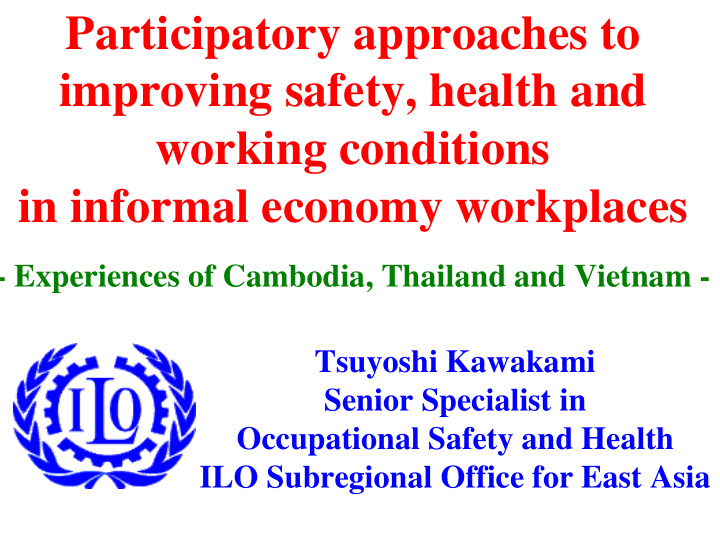



Participatory approaches to improving safety, health and working conditions in informal economy workplaces - Experiences of Cambodia, Thailand and Vietnam - Tsuyoshi Kawakami Senior Specialist in Occupational Safety and Health ILO Subregional Office for East Asia
Structure of the Presentation: Experiences of three countries in improving safety, health and working conditions 1.Cambodia: Networking grassroots initiatives 2.Thailand: Extending occupational health services through Primary Care Units (PCU) 3.Vietnam: Training WIND (Work Improvement in Neighbourhood Development) farmer volunteers
Case 1 Networking grassroots initiatives in improving home workplaces - Experiences of Cambodia -
Reaching home workers through people’s networks Home Home workers workers Workers Employers Home workers Government inspectors Achievement workshops Follow-up visits Government as a facilitator
Start with participatory, action- checklist exercise
WISH (Work Improvement for Safe Home) action checklist with illustrations 21. Increase natural ventilation by having more openings, windows or open doorways. Do you propose action ? o No o Yes o Priority Remarks:……………….………………… ………………………..………………….. 22. Provide adequate clothes and personal protective equipment such as glasses, shoes, and gloves. Do you propose action ? o No o Yes o Priority Remarks:………….……………………… ……………………..…………………….. 23. Provide at least two unobstructed exits from rooms and enough fire extinguishers. Do you propose action ? o No o Yes o Priority Remarks:……….………………………… …………………..………………………..
Group work for identifying practical actions for improvements Group discussion Presentation
Follow-up visits to see improvements
Simple changes improve safety, productivity • Simple seating arrangement >>> Reduced low- back stress • Materials located within easy reach >>> Higher productivity and income (quality products)
Extending WISH training: Training Cambodian trainers to use good example photo sheets
Mobilizing Political Support
Training in Thailand WISH
WISH Training in Mongolia
Case 2 Extending occupational health services through Primary Care Units (PCU) - Experiences of Thailand -
Public Health Service Structure Administration level Agency for health care Public Health Office, Province General Hospital District Health Office/ District Community Hospital Subdistrict PCU (Primary Care Units) Village Health Volunteer
Thai Primary Care Units (PCU) provide occupational health services for workers in informal economies Health consultation services for workers HIV/AIDS For migrant workers
Thai Primary Care Units (PCU) provide occupational health services for workers in informal economies Advisory visit to workplaces
Thai Primary Care Units (PCU) provide occupational health services for workers in informal economies Training village health volunteers
Achievements and Good Practices in PCU approaches 1. Easy and friendly access for people (located in the community); 2. Regular cooperation with provincial and national level health offices; 3. Starting with local workplaces that need immediate support; 4. Combining safety and health issues with other community health issues such as food hygiene, or HIV/AIDS.
Case 3 Training WIND Farmer Volunteers - Experiences of Vietnam -
WIND Programme (Work Improvement in Neighbourhood Development) supports farmers in: - improving safety, health and working conditions; - finding practical, low-cost solutions; - increasing productivity and income; - promoting family, gender and neighbourhood cooperation.
2,810 WIND farmer volunteers in action! Conducting mini WIND workshops WIND Farmer Volunteer
Easy-to-understand illustrations - Safer ways of carrying products -
Easy-to-understand illustrations Safer Storage of Hazardous Chemicals Safer Storage of Hazardous Chemicals
Easy-to-understand illustrations Take frequent short breaks Take frequent short breaks to recover from fatigue to recover from fatigue
Steps to extend WIND training for reaching more farmers Step 1 Collecting existing good practices Step 2 Training by WIND farmer volunteers Step 3 Developing volunteer networks Step 4 Integrating into national programme Step 5 Reaching many farmers
Farmers identify improvement actions using WIND action-checklist
WIND action-checklist with illustrations Action checklist 9. Adjust the work height so that work is done at elbow level or slightly lower than elbow level. Do you propose action ? � No � Yes � Priority Remarks:……………….………………… ………………………..………………….. 10. Provide stable chairs or benches with sturdy backrests. Do you propose action ? � No � Yes � Priority Remarks:………………….……………… …………………………..……………….. 11. Choose work methods to alternate standing and sitting and to avoid bending and squatting postures as much as possible. Do you propose action ? � No � Yes � Priority Remarks:…………….…………………… ………………………..…………………..
WIND farmer volunteers showing local good examples using photo sheets
Improvements implemented by farmers
Safer pesticide storage Storage box with a lock Label written in Vietnamese
Before After
Improvements were possible at low-cost - Results of a WIND training workshop - Improvements/Cost None To- <1US$ <10$ <50$ 50$< tal ***** ***** ***** Kitchen *** * 24 **** * Welfare ***** ***** facilities ***** **** * - 23 **** * Environment ***** *** ** **** - 14 Income * - *** ***** ***** 14 generation Materials ** * **** *** * 11 handling
National support to WIND Farmer Volunteer System to reach more farmers Farmers Farmer trainers Technical support National OSH (Labour, health, Programme agriculture) Government Provincial level
Neighbourhood National policy cooperation support Empowering informal economy workplaces Participatory tools: Low-cost checklists, photo sheets improvements ILO Technical Support
Conclusion Participatory approaches to informal economy workplaces are effective when: 1) Focusing on local peoples’ immediate needs; 2) Promoting workable, low-cost solutions; 3) Strengthening people’s networks for sharing experiences.
Recommend
More recommend